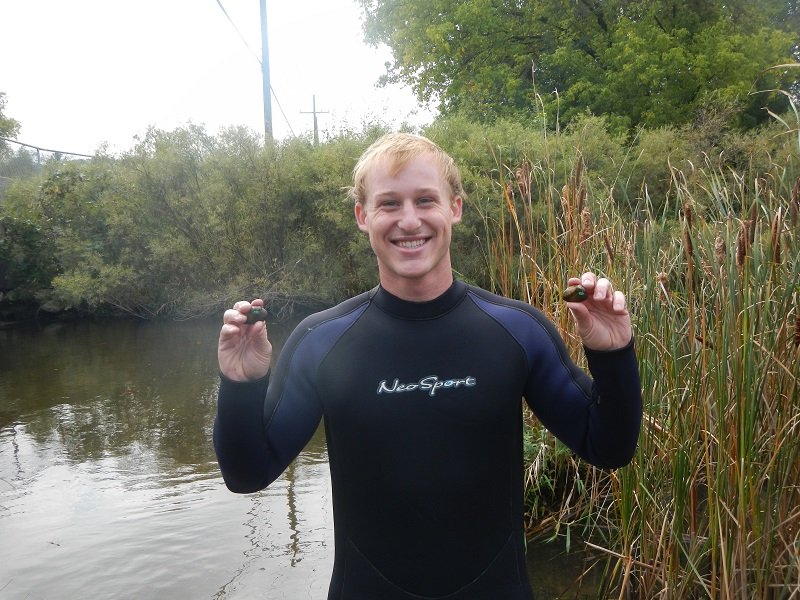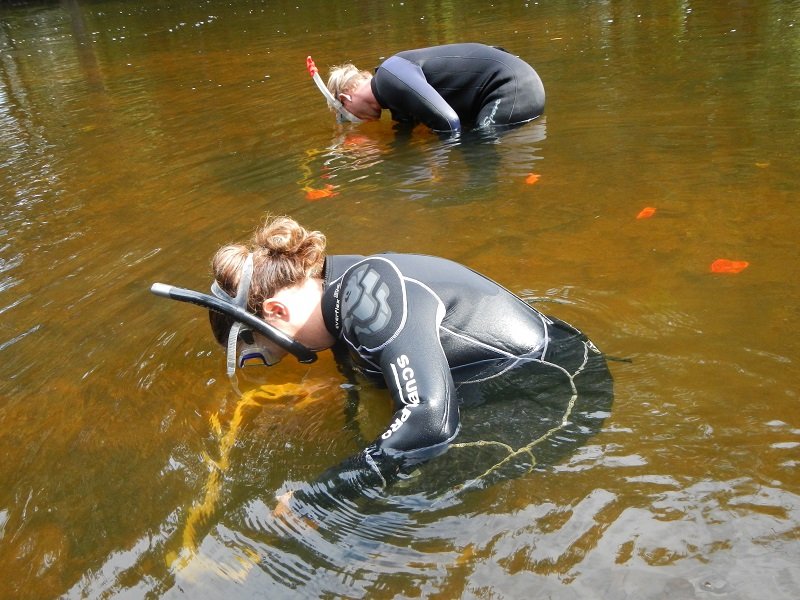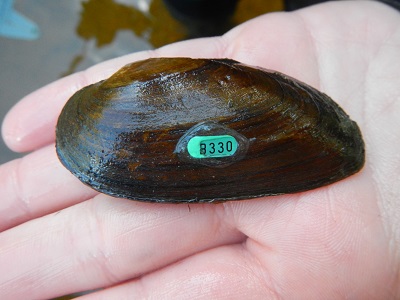Mussels on the Move
 Department of Biology and Institute for Great Lakes Research associate research professor Dr. Daelyn Woolnough and graduate student Kyle Sullivan use their passion for biology to discover the factors that influence the movement of native freshwater mussels. Through a system of capturing, marking, and releasing, the research team was able to track five species of native mussels in the Great Lakes river drainages and better understand the factors that influence their movement during the summer season. Dr. Woolnough and Sullivan’s findings have the potential to improve freshwater mussel conservation efforts.
Department of Biology and Institute for Great Lakes Research associate research professor Dr. Daelyn Woolnough and graduate student Kyle Sullivan use their passion for biology to discover the factors that influence the movement of native freshwater mussels. Through a system of capturing, marking, and releasing, the research team was able to track five species of native mussels in the Great Lakes river drainages and better understand the factors that influence their movement during the summer season. Dr. Woolnough and Sullivan’s findings have the potential to improve freshwater mussel conservation efforts.
Researchers have witnessed a decline in the native freshwater mussel population, specifically in North America, due to a number of factors such as invasive species (including zebra mussels), contaminated waterways, and low water flows. Due to their limited mobility, mussels require a stable environment with high water flows to ensure long-term survival. With extended exposure to low flows, mussels become vulnerable to being dislodged from the riverbed. While dislodgment may not directly cause death, it does require the mussels to re-allocate their energy in pursuit of a more desirable habitat. This uses up valuable energy the mussel could otherwise use for food acquisition or reproduction. When low-flows occur, the mussels move to avoid dislodgment by digging vertically into the riverbed or moving horizontally. Curious to learn more about the factors that influence these movements, Dr. Woolnough and Sullivan took to rivers in the Great Lakes region.
 To examine the differences in movement among five freshwater mussel species, the research team collected data from three sites that drain into the Great Lakes: the Clinton River in Waterford, Michigan; the Grand River in Lyons, Michigan; and the Flat River in Lowell, Michigan. Using mark-recapture techniques, Dr. Woolnough and Sullivan were able to observe a total of 85 mussels from 5 species across their sites. Once the mussels were captured, marked with tags, and released, the team used GPS technology to locate the tags and measure their vertical and horizontal travel distance over the duration of the summer. Differences in shell length and water depth were also measured to better understand the factors that influence these movements.
To examine the differences in movement among five freshwater mussel species, the research team collected data from three sites that drain into the Great Lakes: the Clinton River in Waterford, Michigan; the Grand River in Lyons, Michigan; and the Flat River in Lowell, Michigan. Using mark-recapture techniques, Dr. Woolnough and Sullivan were able to observe a total of 85 mussels from 5 species across their sites. Once the mussels were captured, marked with tags, and released, the team used GPS technology to locate the tags and measure their vertical and horizontal travel distance over the duration of the summer. Differences in shell length and water depth were also measured to better understand the factors that influence these movements.
 As predicted, water depth influenced the burrowing behavior of the sampled mussels. However, the results suggest that the water’s flow variability, defined by how much the flow of water changes over time, had the most influence on horizontal movement. For example, the team found an association between increased flow variability and decreased horizontal movement rates in the sampled mussels. They were also intrigued by how much the shell length influenced vertical burrowing behavior. Shell length and size typically indicate a mussel’s age; larger and longer shells are often associated with older mussels. Through their study, Dr. Woolnough and Sullivan found that, contrary to what is generally thought by mussel ecologists, the larger and older mussels were more likely to burrow below the riverbed surface than the smaller and younger mussels.
As predicted, water depth influenced the burrowing behavior of the sampled mussels. However, the results suggest that the water’s flow variability, defined by how much the flow of water changes over time, had the most influence on horizontal movement. For example, the team found an association between increased flow variability and decreased horizontal movement rates in the sampled mussels. They were also intrigued by how much the shell length influenced vertical burrowing behavior. Shell length and size typically indicate a mussel’s age; larger and longer shells are often associated with older mussels. Through their study, Dr. Woolnough and Sullivan found that, contrary to what is generally thought by mussel ecologists, the larger and older mussels were more likely to burrow below the riverbed surface than the smaller and younger mussels.
Dr. Woolnough and Sullivan’s findings provide valuable insight into the different flow conditions that many native freshwater mussels found in the Great Lakes region endure during the summer. This research has the potential to aid in the conservation of freshwater mussels across North America.
At CMU We Do Research, We Do Real World
Story by ORGS intern Hailey Nelson
August 2021